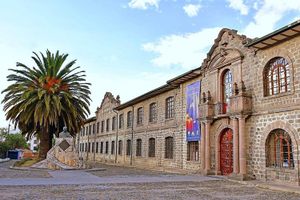
The Centro Cultural Biblioteca Ecuatoriana Aurelio Espinosa Pólit is a “secret” museum that even many Quiteños (residents of Quito) are unaware of. It is a former Jesuit boarding school, initially converted into a library and now a cultural center. From the outside, it looks like an isolated mansion shielded by high walls, but inside, it holds true treasures of Ecuadorian history and literature — some of them rather macabre.
The museum has 12 rooms, including corridors showcasing Ecuadorian art such as biblical paintings and many crucifixes, as well as rooms featuring exhibitions on natural sciences and archaeology. But what makes this museum truly special goes beyond the conventional:
Millenarian Paintings and Hidden Messages: A corridor filled with works by Ecuadorian painter Mideros that depict apocalyptic and prophetic scenes. These paintings will make you feel like you’re inside a mystery film — some say there are actual secret messages in the artwork.
A Map Room: This room displays original 18th-century maps, giving visitors a glimpse into the age of exploration and adventure while revealing how small the world once seemed. One highlight is a map of the failed English assault on Cartagena de Indias — hats off to Blas de Lezo!
Erotic Art: In a Jesuit school? Yes, indeed. The archaeology room features pre-Columbian ceramic pieces that portray one of humanity’s oldest pleasures — or at least Ecuadorians’.
Relics and Blood: The choir of the old chapel includes a section dedicated to Quito’s quintessential saint, Marianita de Jesús. Here, alongside paintings of her life, you’ll find relics such as miraculous blood, pieces of cloth, and even her signature — testaments to the deep faith she inspired in Quito’s Catholics.
A President-Turned-Saint and His Bones, Preserved as Talismans: García Moreno, a 19th-century conservative president and key figure in Ecuadorian history, was assassinated with machetes. He has not just a section but an entire room (almost a chapel) dedicated to him. Here, visitors can see not only the clothing he wore and the weapon that killed him but also parts of his bones, revered as relics of a political martyr.
0 comments:
Post a Comment